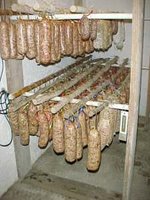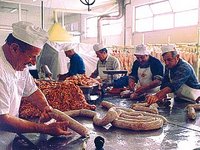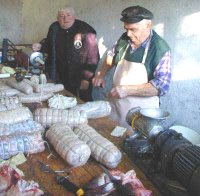Artegna, Friuli, Venezia, Giulia – Re Purcit in Staiare – Celebration of the Pig
written by David Anderson limited rights reserved ViewItaly.blogspot.com
 Purcit, in the dialect of Friuli, means pig. Staiare is the ancient Friulano dance, a variation of the Stiria Asburgica, of celebration. The dance was an integral part of the town’s local festivities. Purcit in Staiare is similar to the Thanksgiving holiday in the US. It is a time of thanks when the family’s pigs were slaughtered guaranteeing a nutrient source of meat for the upcoming winter. The pigs were a family’s greatest value.
Purcit, in the dialect of Friuli, means pig. Staiare is the ancient Friulano dance, a variation of the Stiria Asburgica, of celebration. The dance was an integral part of the town’s local festivities. Purcit in Staiare is similar to the Thanksgiving holiday in the US. It is a time of thanks when the family’s pigs were slaughtered guaranteeing a nutrient source of meat for the upcoming winter. The pigs were a family’s greatest value. The day of Saint Andrea, in the early morning light, the atmosphere was solemn when the butcher, both respected and feared, would arrive in the family’s home. As the day progressed and the salami, prosciutto, sausages, culatello, pancetta and zampone were prepared, the air would become more joyous and festive. The job was intense involving all members of the family, from the youngest to the most elder as the cellars filled with the meats hung to dry.
The day of Saint Andrea, in the early morning light, the atmosphere was solemn when the butcher, both respected and feared, would arrive in the family’s home. As the day progressed and the salami, prosciutto, sausages, culatello, pancetta and zampone were prepared, the air would become more joyous and festive. The job was intense involving all members of the family, from the youngest to the most elder as the cellars filled with the meats hung to dry.Times have changed. Life in Friuli is no longer tied to the seasons. The Purcit in Staiare is a way for the people to remember times past, to connect with their traditions, their ancestors and the things that make them who they are.
 Every year, the last week in November, 20,000 people of the towns of Friuli and the mountain communities surrounding the area celebrate these traditions in Artegna. During the festivities the fattest pig is crowned king for the day. Although this may seem strange the tale of the King of Artegna explains the mystery.
Every year, the last week in November, 20,000 people of the towns of Friuli and the mountain communities surrounding the area celebrate these traditions in Artegna. During the festivities the fattest pig is crowned king for the day. Although this may seem strange the tale of the King of Artegna explains the mystery.A long time ago there was a kingdom, rich and opulent. All the kingdom’s subjects had enough food to eat and peace reigned throughout the land. In the capital of the kingdom, Artegna, the just and righteous king, Purcit, lived and ruled in the castle of Cjot.
 Each day, after a healthy meal, he would sneak into the hidden dungeons of the castle where a magic talking scale was kept. He would step onto the scale and ask,
Each day, after a healthy meal, he would sneak into the hidden dungeons of the castle where a magic talking scale was kept. He would step onto the scale and ask,“Magic Scale, loyal subject of my realm, who is the fattest of the kingdom?”
Like clockwork, the magic scale would respond,
 “There is no doubt my lord, there are none fatter than you!”
“There is no doubt my lord, there are none fatter than you!”Content the king would return to his daily business. For many years the scene was repeated until one day, to the surprise of the king, the scale said,
“Fat you are my lord, but you must know, that fatter than you, one does exist.”
The king was furious. In rage he jumped up and down on the magic scale until it was broken into little pieces. The king became obsessed by his vanity and would eat and sleep forgetting his responsibilities. He became an evil ruler, taxing his people to near starvation to feed his desire.
Finally the day arrived. The king was sure that he no one could be fatter than he. He ordered all of his subjects summoned for a banquet to celebrate his opulence. On the day of his celebration the banquet halls were filled with every sort of food and his subjects, starved and broken, were around the hall to watch the king enjoy his feast. The king ate and ate. A voice arose from the crowd, desperate with hunger,
 “To the table!”
“To the table!”The entire kingdom swarmed over the banquet and the king crushing him. The king was then carved and served to the people by the royal butchers and it is said there was sufficient meat to feed the entire kingdom for a year.
To this day the king of the day is the fattest pig in the kingdom, Il Re Purcit!
Tags: Udine Food and Wine Dried Meats Purcit Prosciutto Sausage Italian Vacations Friuli Travel Italy
Labels: Friuli, Gourmet Foods, Italian Vacations, Pork, Udine



2 Comments:
Celebration of the pig! It would be nice to actually be there and experience the festive atmosphere with the locals. Those sausages look so delicious. Good story for the background information. So is this celebration nation wide? Is it pretty commercialized like thanksgiving here in north america? or is it still very traditional?
9:25 PM
Jas While most regions of Italy celebrate in some way the fall preparation of dried meats this holiday is Friulano, from the Northeastern part of Italy. Most regional celebrations do have some type of ties to commerce but it is more a way for consumers to come into contact with farmers and butchers. In other words each celebration of festivity will have a local fair with local producers. It would not be anything like the commercialization here in the US.
8:46 AM
Post a Comment
<< Home